|
|
|
This is a tribute to Jimi Hendrix "Purple Haze, Jesus Saves"





 THE JIMI HENDRIX EXPERIENCE
THE JIMI HENDRIX EXPERIENCE
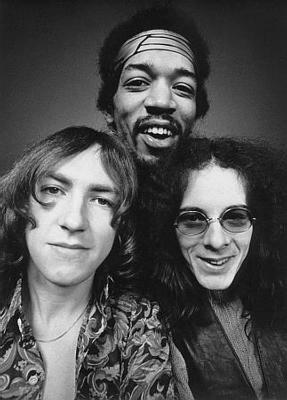
MITCH,JIMI,NOEL

Jimi Hendrix expanded the range and vocabulary of
the electric guitar into areas no musician had ever ventured
before. Many would claim him to be the greatest guitarist
ever to pick up the instrument. At the very least his
creative drive, technical ability and painterly application
of such effects as wah-wah and distortion forever
transformed the sound of rock and roll. Hendrix helped usher
in the age of psychedelia with his 1967 debut, Are You
Experienced?, and the impact of his brief but meteoric
career on popular music continues to be felt.
More than any other musician, Jimi
Hendrix realized the fullest range of sound that
could be obtained from an amplified instrument. Many musical
currents came together in his playing. Free jazz, Delta
blues, acid rock, hardcore funk, and the songwriting of Bob
Dylan and the
Beatles all figured as influences. Yet the songs and
sounds generated by Hendrix were original, otherworldly and
virtually indescribable. In essence, Hendrix channeled the
music of the cosmos, anchoring it to the earthy beat of rock
and roll.
Hendrix was born Johnny Allen Hendrix on November 27th,
1942, in Seattle (his name was changed to James Marshall
Hendrix four years later). He acquired his first guitar at
age 16 and joined a group, the Rocking Kings, a year later.
Following an abortive stint in the Army, he hit the road
with a succession of club bands and as a backup musician for
such rhythm & blues artists as Little
Richard, the
Isley Brothers, Jackie
Wilson, the
Impressions and Sam
Cooke. In 1966 he was discovered by Chas Chandler,
the former Animals bassist, while performing at New York's
Cafe Wha? with his group, Jimmy James and the Blue Flames.
Chandler became Hendrix's manager and brought him to
England, where he absorbed the nascent psychedelic movement,
changed the spelling of his first name "Jimi" and formed a
trio with bassist Noel Redding and drummer Mitch Mitchell.
The Jimi
Hendrix Experience recorded three landmark albums -
Are You Experienced?, Axis: Bold As Love and Electric
Ladyland - in a year and a half. Hendrix's theatrical,
incendiary performances at the Monterey Pop and Woodstock
festivals, including the ceremonial torching of his guitar
at Monterey, have become part of rock and roll legend. Under
extreme pressure due to a combination of nonstop work,
sudden celebrity and drug-taking, the trio broke up in early
1969. Hendrix commenced work on a projected double album and
debuted a new trio, Band of Gypsies, at the Fillmore East on
New Year's Eve 1969. Hendrix performed his last concert at
the Isle of Fehmarn, Germany on September 6, 1970 (though he
joined Eric Burdon and War on stage on September 16 at
Ronnie Scott's in London). On September 18, he died from
suffocation, having inhaled vomit due to barbiturate
intoxication.
In the wake of Hendrix's death, a flood of posthumous
albums - everything from old jams from his days as an R&B
journeyman to live recordings from his 1967-1970 prime to
previously unreleased or unfinished studio work - hit the
market. There have been an estimated 100 of them, including
Voodoo Soup (1995), an attempt to reconstruct First Ray of
the New Rising Sun - the album Hendrix was working on at the
time of his death - from tapes, notes, interviews and song
lists.
TIME LINE
November 27, 1942
Johnny Allen Hendrix is born at 10:15 a.m. at Seattle's King
County Hospital. His mother is Lucille Jeter, 17. His
father, James "Al" Hendrix, is in the U.S. Army, stationed
in Camp Rucker, Alabama.
November 27, 1942
Johnny Allen Hendrix is born at 10:15 a.m. at Seattle's King
County Hospital. His mother is Lucille Jeter, 17. His
father, James "Al" Hendrix, is in the U.S. Army, stationed
in Camp Rucker, Alabama.
December 25, 1945
Noel Redding was born.
September 11, 1946
Al Hendrix, now out of the service, changes his son's name
to James Marshall Hendrix. Al will take primary
responsibility for raising Jimi. "My dad was very strict and
taught me that I must respect my elders always. I couldn't
speak unless I was spoken to first by grown-ups, so I've
always been very quiet," Hendrix said of his childhood.
July 9, 1947
Mitch Mitchell was born.
September 1, 1957
Jimi Hendrix goes to see Elvis
Presley perform at Sicks Stadium.
February 2, 1958
Jimi Hendrix's mother dies.
SUMMER 1958
Jimi Hendrix's father buys him a second-hand acoustic
guitar. It costs five dollars. "Jimmy told me about it [the
guitar] and I said, ‘Okay,' and gave him the money. He
strummed away on that, working away all the time, any spare
time he had," said Al.
SUMMER 1959
Al Hendrix buys Jimi his first electric guitar, a Supro
Ozark 1560 S. Jimi joins the Rocking Kings. "My first gig
with them was at a National Guard armory. We earned like 35
cents apiece. We used to play stuff by people like the
Coasters," said Jimi.
SUMMER 1961
Jimi Hendrix enlists in the Army. Stationed at Fort Ord,
California, he writes home: "The Army's not too bad, so far.
. . . All, I mean, all my hair's cut off and I have to
shave. . . I won't be able to see you until two months from
now. . . we're going through basic training."
November 1, 1961
Now stationed at Fort Campbell, Kentucky, Jimi Hendrix is
training to become a paratrooper. Meanwhile, he forms a
band, the King Kasuals, with a fellow soldier, Billy Cox.
July 2, 1962
After getting hurt during a jump, Jimi Hendrix gets an
honorable discharge from the Army. Over the next three
years, he will play numerous gigs and studio sessions with
such R&B stars as Little
Richard, the
Isley Brothers, Ike
and Tina Turner and Sam
Cooke.
April 1, 1965
Jimi Hendrix goes to New York with Little
Richard's band and takes a room at the Theresa
Hotel. Over the next several months, he will play with Little
Richard, King
Curtis, Joey Dee and the Starlighters and the
Isley Brothers. He also takes a job with a club band
called Curtis Knight and the Squires.
June 1, 1966
Jimi Hendrix forms a band called Jimmy James and the Blue
Flames, which also includes guitarist Randy California,
later of the group Spirit. They get a regular gig at Café
Wha? in Greenwich Village.
September 24, 1966
Jimi Hendrix and Chas Chandler, former bassist with the
Animals, fly from New York to London. There, Hendrix
will form a new band and Chandler will become the manager
of the
Jimi Hendrix Experience. En route, they decide to
change the guitarist's name from Jimmy to Jimi.
October 1, 1966
Hendrix jams with Cream at
the Regent Polytechnic College.
October 6, 1966
The Jimi Hendrix Experience holds its first rehearsal. The
group features Jimi on guitar, Mitch Mitchell, formerly of
Georgie Fame's Blue Flames, on drums, and Noel Redding on
bass. The following week, the Experience plays a four-day
French tour supporting Johnny Hallyday.
October 23, 1966
The Jimi Hendrix Experience records its first two songs,
"Hey Joe" and "Stone Free" at London's De Lane Lea Studios.
December 16, 1966
The Jimi Hendrix Experience release "Hey Joe" in England. By
February 1967, it reaches Number Four on the British charts.
The next single, "Purple Haze," reaches Number Three. The
group's debut album, Are You Experienced?, will remain near
the top of the charts through the summer of 1967.
June 18, 1967
Jimi Hendrix performs at the Monterey International Pop
Festival. Brian Jones of the
Rolling Stones introduces him as "the most exciting
performer I've ever heard." At the end of his performance,
he burns his Fender Stratocaster. "The time I burned my
guitar it was like a sacrifice," Jimi said. "You sacrifice
the things you love. I love my guitar. I'd just finished
painting it that day and was really into it." Literally
overnight, the
Jimi Hendrix Experience become one of the most
popular acts in rock music.
December 1, 1967
The Jimi Hendrix Experience releases 'Axis: Bold as Love'.
The album, which is released in the U.S. on January 15,
includes such songs as "Little Wing," "If Six Was Nine,"
"Castles Made of Sand" and "Spanish Castle Magic."
February 1, 1968
The Experience embarks on a major U.S. tour. The first show
is at the Fillmore, in San Francisco. On February 12, Jimi
Hendrix returns to Seattle for a show at the Center Arena.
Jimi's family is seated in the front row.
October 18, 1968
Jimi Hendrix's version of Bob
Dylan's "All Along the Watchtower" is released.
"Before I came to England, I was digging a lot of the
things Bob
Dylan was doing," Jimi said. "He is giving me
inspiration."
October 25, 1968
Electric Ladyland, a double album recorded in the
U.S. and England, is released. It becomes Hendrix's first
Number One album in the U.S. and includes such tracks as
"Voodoo Chile," "Crosstown Traffic" and "All Along the
Watchtower."
February 24, 1969
The Jimi Hendrix Experience plays its last British
performance at London's Royal Albert Hall.
June 29, 1969
The Jimi Hendrix Experience plays the final date on its last
American tour at the Denver Pop Festival. At the height of
its popularity, the group breaks up.
AUGUST 15-17, 1969
The year 1969 was the year of the rock festival. The largest
was the Woodstock Music and Art Fair, held on the weekend of
August 15-17 in the tiny town of Bethel, in upstate New
York. An estimated crowd of 450,000 attended the event,
which featured everyone from Jimi Hendrix and Joe Cocker, to
Arlo Guthrie, the Jefferson
Airplane, the
Who, Janis
Joplin, Sly
and the Family Stone, Ravi Shankar and Country Joe
McDonald. If Woodstock marked the apex of the hippie
movement in America, the
Rolling Stones' free concert in Hyde Park did the
same for England. Held on July 5, the show drew nearly
300,000 people, the largest gathering in England since V-E
Day.
August 18, 1969
Hendrix debuts a new band, Gypsy Sun and Rainbows, at the
Woodstock music festival in New York State. The group
includes old friend Billy Cox on bass, Mitch Mitchell on
drums, Larry Lee on rhythm guitar and Juma Sultan and Jerry
Velez on percussion. He takes the stage at 7:30 in the
morning, and his version of "The Star Spangled Banner"
becomes the highlight of the festival.
DECEMBER 31, 1969 - JANUARY 1, 1970
Band of Gypsys – a trio with Hendrix, Cox and drummer Buddy
Miles – plays Bill
Graham's Fillmore East in New York. Graham calls the
shows "the most brilliant, emotional display of virtuosic
electric guitar playing I have ever heard."
April 28, 1970
Jimi Hendrix and the
Band of Gypsies "The Cry of Love" tour begins at the
Forum in Los Angeles. Mitch Mitchell is back on drums.
SUMMER 1970
The Cry of Love with the
Band of Gypsies tour continues, with shows at
Berkeley, Rainbow Bridge in Hawaii and the Atlanta Pop
Festival. The group begins work on a new double album,
'First Rays of the New Rising Sun'. Though some of the
tracks are released as The Cry of Love, the album
does not get its full release until 1997.
August 25, 1970
A grand opening party is held at Electric Lady Studios,
which Jimi has designed for himself in New York.
August 30, 1970
Hendrix performs at the Isle of Wight Festival in England.
September 6, 1970
Hendrix, Cox and Mitchell play the Love and Peace Festival
in Puttgarden, Germany. Hendrix then returns to London.
September 16, 1970
Jimi Hendrix jams with Eric Burdon and War at Ronnie Scott's
Club.
September 18, 1970
Jimi Hendrix dies in his sleep at the Samarkand Hotel in
London. He was 27.
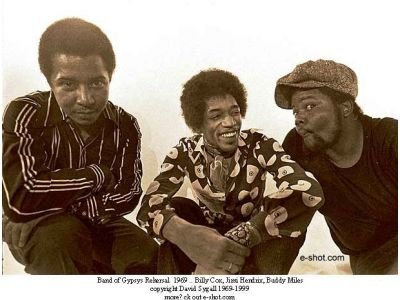

Jimi Hendrix
Band of Gypsys:
09/18/1970
The spiritual bishop of rock and roll, the man who united the streams of
R&B, blues, funk and rock into such a fantastic animal, died today.
Jimi leaves in his wake his final record. Released just five months
ago, Band of Gypsys documents one of Jimi's classic moments on stage at
the Fillmore East in New York City on New Year's Eve, 1970. Though it
serves now as a requiem, the album began its life as the promise of
birth. Jimi had grown tired of his poppier arrangements and was ready to
thrust himself into a new experimental stage with his two-man band of
Buddy Miles and Billy Cox abreast. The Fillmore East performances
suggested that Jimi was moving into new territories. He had established a
platinum reputation, and the only thing left to hold him back was his
own imagination. Band of Gypsys shows us how far that imagination may
have gone had it not been so hastily ripped from our presence.
Band of Gypsys is a tremendously organic, moody creature to invite into
the ears. Running the gamut from intense, climactic moments of intensity
to distorted, minimal suspense, Gypsys is a stunning departure from
Jimi's more wry, grittier material like "Hey Joe" or "Highway Chile." As
if the social tumult of racial strife and an unwilling war had been
swallowed by Jimi's guitar and released again by his fingertips, Gypsys'
atmosphere is introspective, regretful, frustrated, and angry-- the
cries of protest from a man whose words were his music.
Perhaps the most fantastic aspect of this record is the crowd. Though
the tempo often changes to silence excepting only a lightly tapped
hi-hat or tremblingly picked guitar, the silence in the rapt Fillmore
East captures the power of the performance. If silence is golden, the
crowd has paid Jimi, Buddy and Billy the highest ransom to express
themselves to the fullest, and the favor is returned. Remember him, my
brothers and sisters. Amen.

Jimi Hendrix at Band of Gypsys, 1969

Jimi Hendrix at Band of Gypsys rehearsal with Buddy Miles on drums, NYC, 1969
|
|
|
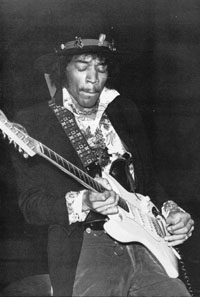

JIMI'S FUNERAL
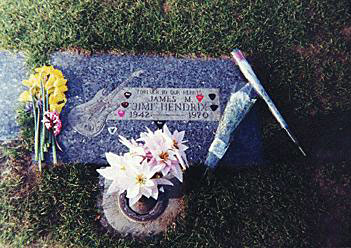
Jimi's grave Greenwood Memorial Park, Renton, Washington USA



The Jimi Hendrix Experience on stage at the Fillmore East, May, 1968


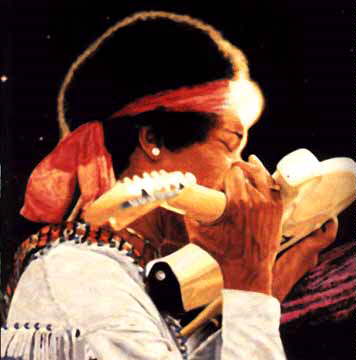
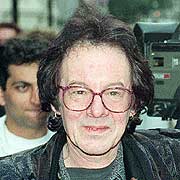
Bassist for Jimi Hendrix Experience dies MAY/11/2003
DUBLIN, Ireland (AP) — Noel Redding, bass player for the legendary
Jimi Hendrix Experience from its formation in 1966 through its
dissolution three years later, has died. He was 57. Redding was found
dead Monday at his home in the town of Clonakilty in southern Ireland,
his manager, Ian Grant, said Tuesday. An autopsy was planned to
determine the cause of death.

Noel was an extremely gentle and gracious soul. He had a kind of
chivalry and nobility about him and he was kind to everyone bar none,
people and animals alike," said Deborah McNaughton, his longtime
partner.
Chas Chandler, a former bassist for The Animals who became a rock
manager, recruited Redding and drummer Mitch Mitchell to form the
Experience with Hendrix in England.
The band produced three groundbreaking albums of psychedelic rock —Are
You Experienced?, Axis: Bold as Love and Electric Ladyland. Its hits
included Purple Haze, Hey Joe and Foxey Lady.
The group broke up in 1969 before the famed Woodstock appearance by
Hendrix, who died the next year from choking on his vomit after taking
sleeping pills and drinking wine.
Redding wrote two Experience songs: She's So Fine and Little Miss
Strange.
Born Dec. 25, 1945, in the English Channel port city of Folkestone,
Redding played with the Modern Jazz Group and the Loving Kind before
joining the Experience.
He has said that his greatest achievement was playing the 1967 Monterey
Pop Festival, where the Experience made its American debut and Hendrix
lit his guitar on fire, and the band's 1992 induction into the Rock and
Roll Hall of Fame in Cleveland.
After the breakup of the Experience, Redding formed his own band, Fat
Mattress, which released a 1969 album of the same name, followed by Fat
Mattress 2 in 1970. Both were re-released as a set in 2000.
Later, he formed the Noel Redding Band, which recorded Clonakilty
Cowboys in 1975 and Blowin' in 1976. Other recordings included On Tour
in 2001 and last year's Live From Bunkr-Prague.
In 1990, Redding and Mitchell each published books about their
experiences.
"Jimi's death was the most lucrative act of his sad career," Redding
wrote in Are You Experienced? in which he alleged that the Hendrix
estate owed him money.
In February, Redding threatened to sue Experience Hendrix, the company
that manages the Hendrix catalogue, for up to $5 million in lost
earnings. The estate rejected the claim.
On Tuesday, the Experience Hendrix Web site mourned Redding's death,
saying, "His contributions to the Jimi Hendrix Experience shall never be
forgotten."
Redding played most Friday nights for the last 20 years at De Barra, a
local pub, Grant said, often with his friends John Coughlin from Status
Quo and Eric Bell of Thin Lizzy.
Redding had no children. A funeral was planned for the weekend in
Clonakilty.
THE DRUMMER MITCH MITCHELL
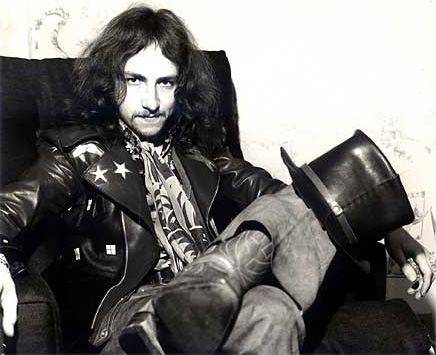
John Ronald "Mitch" Mitchell (9 July 1947 – 12 November 2008) was an English drummer, best known for his work in The Jimi Hendrix Experience
Mitch Mitchell...
A child actor, Mitch was largely self taught, though he received some
lessons when he worked in Jim Marshall’s (the Amp man) music store.
Mitch did some free lance work before settling in with Georgie Fame and
the Blue Fames. One of the great UK jazz inflected R&B bands. After
18 months George fired the whole band as management wanted a change in
direction. The next day Mitch got a call from Chas Chandler to come and
try out with this American he was managing. Mitch was invited to join
for two weeks work
touring France. One of the great musical synergies was born.
Jimi Hendrix has a magnificent rhythmic drive, his playing sets the
groove. He also has a strong idea what the bass player is to play.
Indeed he is a pretty good bass player himself as on several tracks he
replaced Noel Redding and recorded the bass himself ("All Along the
Watchtower",
"1984…"). With Jimi setting the groove and the bass player holding it
and following his lead, the drummer had great opportunity to fill and
interact. Jimi and Mitch are closer to Townshend and Moon, then with
Cream (Baker had two lead guitarists!).
Mitch is a jazz influenced player, especially Elvin Jones but also Max
Roach and Joe Morello. He uses the underhand or military grip switching
to matched for tom work. He used a variety of kits: first Premier with
20" bass & 14x 8" top tom, then a Ludwig Silver Sparkle in the
classic jazz setup: 22" bass, 13x9" top, 14x14" & 16x16" floor,
Ludwig Supra-phonic snare. Cymbals varied but typically: 15" Hi-hat, 20"
ride, 20" & 22" crash and later a 22" or 24" riveted ride. In 1969
he moved to a Ludwig double bass kit with 24" bass drums and additional
12x8" top tom, then the same setup on Gretsch (possibly Ludwig
sponsorship in Europe and Gretsch in USA). The double kit didn't change
his style, it just added some tonal variety. Sticks were medium/heavy
and he played seated low in a hunched position.
Mitch plays in the Elvin Jones explosive style with fast snare and
cymbal riding coupled with more basic rock triplet bass patterns and big
bombs. In line with jazz drumming he played within the
snare/hi-hat/ride cymbal/bass drum arc with the toms as variations. His
hi-hat and cymbal work is of the highest order and he used brushes on
occasions. He is criticised as a busy drummer which is grossly
overstating the case. More restrained drumming may have been more
appropriate on a few tracks (that’s Mitch’s opinion). I really can’t
describe them as flawed, just that it could have been done differently
and that doesn’t mean better!
The thing that Mitch had was incredible stamina especially in the studio
as Hendrix endlessly worked though songs. He always responded to
Hendrix’s variations and worked from his arrangement. Mitch never
defined his arrangement within the song. Live was the same, as it was
need to follow Hendrix’s improvisations and also fill in those gaps,
especially when Hendrix did his stage act. It was behind these that
Mitch took his solo over a droning bass line, usually at an exciting
high tempo. He was a fast drummer - lightning at times and surprisingly
loud for his diminutive statue. But as a true soloist he could not
retain momentum - the solo on "Voodoo Child" looses momentum
surprisingly quickly. This is a result of the lack of thorough formal
training and the techniques that it provides to build a coherent solo - a
limitation of no relevance in this band.
Mitch’s critical asset was his explosive, intuitive responsiveness to
Jimi. He could lay down a strong, light groove but then instantly react
as Hendrix shifted gears or moved off in another direction. His style is
in stark contrast to Buddy Miles who lays down a relentless groove
which, when combined with the solid groove bass playing of Billy Cox,
stultified Hendrix.
Mitch’s return freed up Hendrix and Billy Cox as well. I really cannot
conceive of Baker playing this sort of role - his personal rhythmic
impetus would also have impeded Hendrix but not as greatly as Miles.
After Jimi died, Mitch languished in some ordinary projects. The one
that had the greatest potential was the Jack Bruce/Larry Coryell/Mitch
Mitchell/Michael Mandell jazz/rock fusion band. The available bootlegs
show Mitch playing in a jazzier style with some Bakerish inflections
with the tom fills. What I find most interesting is that the rhythmic
drive is coming from Jack, allowing Mitch to fill, reinforce and explode
but in a controlled way. That was a good band that should have gone on
but Jack got the irresistible call to join the Tony Williams Lifetime.
The third of the great British Rock drummers of the ‘60s, with a very
different style and technique. His legacy is an indispensible part of
that of Jimi Hendrix’s …’nough said.
Greatest moments: "Manic Depression", "Fire", "Crosstown Traffic" (the
groove), "Hey Baby (New Rising Sun)"and the BBC sessions.
Historical Footnote: Ginger and Mitch were not rivals, in fact they were
friendly members of the drummers club. On the night that Jimi died,
they had picked up Sly Stone from London airport and were looking for
Jimi to participate in a jam.
BUDDY MILES DRUMMER BAND OF GYPSYS.
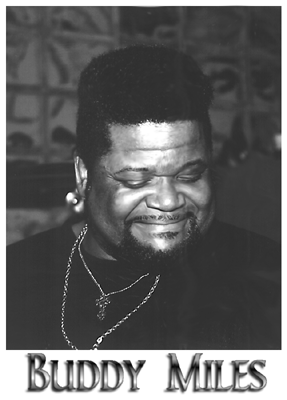
George Allen Miles, Jr. (September 5, 1947 – February 26, 2008), known as Buddy Miles,
Miles has come a long way since his first professional gig, when at the
age of twelve he began playing drums in his father's jazz combo in
Omaha, Nebraska. It was only a matter of time before his inimitable
bottom-heavy style attracted the attention of the multitudinous R&B
and doo-wop groups who were touring the chitlin' circuit and,
eventually, the teenaged Miles landed a seat as part of Wilson Pickett's
live revue.
In 1967, while performing with Pickett, he was approached by Michael
Bloomfield and Barry Goldberg and asked to join a new psychedelic rock
band called The Electric Flag. With Miles on drums, the Flag recorded
one high-voltage slab of vinyl before parting ways in 1968. Up from the
skies came the freshly-formed Buddy Miles Express and a renewed
friendship with Jimi Hendrix, with whom Miles had been running as early
as June of 1967, when the two played the Monterey Pop Festival.
Hendrix's archetypal and apocalyptic Electric Ladyland marked the
beginning of their fruitful collaboration in the studio, with Miles
laying down a solid backbeat dripping with the blues for "Rainy Day" and
"Still Raining." Hendrix would return the favor by writing the
beautifully envisioned liner notes for BME's EXPRESSWAY TO YOUR SKULL
and producing tracks for the follow-up ELECTRIC CHURCH in 1969.
After the breakup of the Jimi Hendrix Experience in late 1969, Hendrix
recruited Miles for what would be one of the lasting musical statements
of both their careers. Over the protests of his management, who feared
the repercussions of adopting a so-called "Black Power" stance in his
music, Jimi formed the Band of Gypsys with Billy Cox on bass and Miles
on drums and backing vocals. Arguably the first true "black rock" band,
the Gypsys debuted at Bill Graham's Fillmore East on New Year's Eve 1970
and opened their historic second set with the Hendrix classic "Machine
Gun." Writer David Henderson described Miles in action in 'Scuse Me
While I Kiss the Sky, the definitive Hendrix biography:
"Buddy Miles pauses, eyes closed, like a Buddha within a silver metal
bubba flowing outward, his snare shots wide and strong. He beats into
the depths of a groove, the snare shots ratatatting stronger and
stronger. Miles captures and entrances you with his repetition. The
intensity of his shots ring out on par with Jimi's guitar."
The Fillmore set formed the basis of the Band of Gypsys live album,
which featured two tracks written by Miles "We Gotta Live Together" and
the seminal "Them Changes," which has since become the signature song of
the Express. Ironically, although Band Of Gypsys was in many ways a
breakthrough for Hendrix, the group dissolved scarcely two months later
for reasons that remain mysterious even to this day. Miles-o-philes can
dig other Gypsys cuts on the obscure Hendrix collection, "Loose Ends,"
an invaluable document of rehearsals and outtakes that features the
extended funk workout "Burning Desire."
"Twenty years ago, before Living Colour and the Black Rock Coalition,
there was Buddy Miles and his visceral Hard Soul....Hell And Back may be
an apt description of where he's been, but Buddy uses it all as
inspiration for this diverse record of behind the beat fatback funk and
hard R&B jamming." -- MODERN DRUMMER
BILLY COX BASS BAND OF GYPSYS:

William "Billy" Cox (born October 18, 1941) is an American bassist, best known for performing with Jimi Hendrix.
As of November 12, 2008, he is the only surviving member of both The Jimi Hendrix Experience and the Band Of Gypsys
Billy Cox really needs no introduction. Jimi's close friend since they
met in the Army at Fort Campbell, Kentucky, Billy was the bass player in
the legendary Band of Gypsys and toured and recorded with Jimi for the
last year and a half of his life.Billy Cox
Born in West Virginia, DOB unknown.
Billy Cox holds a unique position in the life of Jimi Hendrix. Cox knew
and played in bands with Hendrix before he became famous, and after.
Billy first met Hendrix in the early part of the Sixties, when they were
both in the Army. Cox, a bass player, teamed with Hendrix in an R &
B band called the King Casuals.
They re-united musically in 1969, when Hendrix called on Cox to play
bass in the experimental funk band the Band of Gypsys.
Billy Cox played at Woodstock with Hendrix's Gypsy Sun and Rainbows, and
toured with Hendrix (with Mitch Mitchell on drums) for most of 1970 on
the Cry of Love tour.
Cox lives in Nashville TN. where he remains active in music, and acts as
an ambassador for Jimi Hendrix, his music and philosophy.



It´s like trying to get out of ROOM FULL OF MIRRORS
Despite everything written about Jimi Hendrix since his death, vital
questions remain unanswered. The Coroner's "Open Verdict" could stand as
a final
comment on his life. In the light of facts unearthed since 1970 we
present a detailed reconstruction of his last eighteen months, and his
last hours.
THE JIMI Hendrix Experience, put together by Chas Chandler in 1966, was
moribund only two years later. The Experience had gone up like a rocket,
trailing clouds of glory, sensationalism and instant success. By 1968
it had burned itself out. A handful of brilliant singles, two
crackerjack albums - the first an explosive flash, the second a slow
burn - and gigs of ferocious visual and aural pyrotechnics were its
legacy.
But Hendrix wanted to be something more than the super hippy stud guitar
hero of his media image. He felt constrained by the limitations of the
three piece - and personality problems with Noel Redding didn't help.
During their tour of Sweden in January '68 Hendrix had been incarcerated
overnight after wrecking a hotel room, following a row with Redding.
(The subsequent fine cost him the proceeds from the tour.) And neither
did his difficulties with Mike Jeffrey, Chandler's partner, who wanted
the success formula to continue.
The third album, the double 'Electric Ladyland,' recorded during 68, may
have been for Hendrix a step in the right direction with extended
'unconventional' tracks and a bunch of guest musicians contributing. But
for Mike Jeffrey it was bad news on at least two counts: it was a
double, with therefore a lower "sales profile" (the controversial nudes
cover didn't help either) and musically it was a (large) step away from
"Purple Haze" and "Are You Experienced?" It was also very uneconomically
recorded - over an extended period with much loose jamming and "wasted"
studio time.
But it wasn't only the money-minded Jeffrey who was unhappy with the way
Hendrix was going. Chas Chandler was concerned about Hendrix's
behaviour, which was becoming somewhat unpredictable. In addition, he
was eased out (or quit) as producer during the recording of 'Electric
Ladyland')and in frustration sold out his 50% interest in Hendrix to
Jeffrey.
In November '68 the Experience broke up. They played two farewell gigs
at the Albert Hall in February '69. Chapter One was ended. The only
remaining chapter was to be the epilogue.
A timetable of the last two years of Hendrix' life makes horrifying
reading. A catalogue of wrong moves, false starts, accidents,
misfortunes, contradictions, unanswered questions and downright
disasters, accelerating and intertwining more and more tightly as they
approached the final week, that pose many questions about the reasons
for and events behind Hendrix' death.
IN FEBRUARY '69, Hendrix left for the States. Jeffrey brought Chas back
in again to look after things while he was in America. Hendrix phoned
Chas up and asked him to come back as his manager. Chas refused.
In New York, Hendrix was recording at the Record Plant with Buddy Miles
on drums and Billy Cox on bass, doing a double album which was intended
to be his final statement as a 'pop star.' He desperately wanted to move
on from the rut he found himself in. Alan Douglas, a friend of his, and
who was producing John McLaughlin's 'Devotion' album in the same
building, was asked by Hendrix to be his Foducer. Douglas entered into a
verbal agreement with Jeffrey and for the moment everything was fine.
Hendrix jammed with McLaughlin and organist Larry Young (also on
'Devotion,' who had been with McLaughlin in Lifetime) and other rock
notables.
***
Then in May at Toronto International Airport arriving for a gig, Hendrix
was busted for possession of heroin. He was released on bail of $10,000
but the case was to hang over him till December.
During the Summer and Autumn, Hendrix was mainly living at a house in
Liberty in upstate New York with an 'electric family' of musicians
including Mitch Mitchell, conga player Juma Lewis and avant-garde
pianist Michael Ephron. Naturally, none of this was desirable to his
commerce consciousness management and Hendrix had to escape to Algeria
and Morocco on holiday a couple of times to avoid the presssure.
By June, he was playing again with Billy Cox and Mitch Mitchell, back
with the reassurance of familiar faces. In July they played Newport and
in August, Woodstock. ("You can leave if you want to. We're just jamming
that's all." said an obviously not overhappy Hendrix.) Also in August
was a disastrous gig in Denver which was broken up by tear gas lobbing
riot police.
In December, Hendrix' old manager, Ed Chalpin won his suit against him.
Hendrix had signed with Chaplin when he was in Curtis Knight's band and
thus had renewed on this contract when he left for Britain with
Chandler. Merely for having Hendrix' name on a piece of paper, Chaplin
was given the US rights to one album ('Band Of Gypsys' which came out on
Capitol in America); a percentage or Hendrix' earnings, past and
present; and $ 1 million upfront.
Also in December, on a happier note, Hendrix was acquitted of the
Canadian drugs charge. The defence had been that he did not know about
the heroin which had been put in his bag on his departure by a girl who
said it would be good for the cold from which he was suffering and that
he hadn't opened the package.
John Swenson in the American magazine Crawdaddy however quotes an
anonymous New York musician who says that Hendrix was afraid that the
drug was a plant and that the bust was arranged by Jeffrey to keep him
dependent on Jeffrey at a time when he was obviously slipping our of his
domination. There is however, a strong counter-claim, again anonymous,
that the dope was neither a plant nor an unfortunate present. (Although
the coroner found no needle marks whatsoever on Hendrix' body, it is
accepted that Hendrix did snort heroin. Chris Welch in his biography
'Hendrix' quotes PR man Robin Turner on this.)
On New Year's Eve the all-black Band of Gypsys (Hendrix, Miles and Cox)
debuted at Fillmore East, described by Bill Graham as some of the most
amazing music he'd ever heard but regarded typically less
enthusiastically by Hendrix. (This gig was recorded for the 'Band Of
Gypsys' album that Chalpin got).
At the end of January 1970, Band of Gypsys played their second concert
at a Peace Rally in Madison Square Garden in Front of 19,000 people.
During the second number Hendrix stopped, announced "I'm sorry but we
just can't get it together" and walked off. End of Band of Gypsys.
In May the reformation of Experience was announced. At the end of May
Hendrix played a concert at Berkeley Community Theatre - with Billy Cox
and Mitch Mitchell. No Experience reunion.
Through '69 and early '70, Hendrix was mainly in the studio and also
working towards his own 'dream' studio, Electric Lady, where he could
make his own music in his own environment. But again there were the
inevitable difficulties.
Hendrix found, to his amazement, that he didn't have enough money to
finance the studio himself and that he had to borrow from Warner Bros.
(his US record company). Biographer Curtis Knight quotes Hendrix: "I
know I have been spending a lot of money lately but I have also been
making a lot of money and I was shocked to learn what my financial
situation is. I had a lot of faith in the people that were handling my
affairs - I trusted them. But there are definitely going to be some
changes made...I am going to get in touch with my lawyer in America and
straighten everything out. The vultures have lived off me long enough."
In June, Hendrix was in Hawaii for the 'Rainbow Bridge' film, although
the soundtrack was recorded at Electric Lady at the beginning of.July.
At the end of July he played his last gig in the States, in Seattle, his
home town. Another catastrophe, with Hendrix reduced to shouting "Fuck
you! Fuck you!" at the audience.
On August 25 there was the opening party for Electric Lady with everyone
getting totally ripped. The next morning, not having slept, Hendrix
flew out for Britain and the Isle of Wight Festival. At 3 a.m. on the
cold, damp morning of 27 he came on to play his last British
performance.
It was followed almost immediately by a European tour and by preliminary
meetings to settle the Chalpin / Jeffrey contract dispute in Britain.
The tour got to Holland where the last date on September 14 in Rotterdam
was cancelled. Billy Cox had had a nervous breakdown and was flown back
to the States. Hendrix returned to London.
On Tuesday 15, Curtis Knight reports a wild party lasting all day in
which Hendrix was a participant. Knight quotes Lorraine James, a 21 year
old shop assistant who saw Hendrix that day: "He was on the coin box in
the building for hours, trying to contact people. One minute he was on
top of the world and the next minute he was moaning about his backers
and his financial affairs."
The evening of Wednesday 16 seems to have been a busy one for Hendrix.
He showed up at Ronnie Scott's club to jam rather badly with Eric Burdon
and War. He also phoned Chas Chandler to ask him to be his manager
again. And also talked with Alan Douglas "all night" trying to persuade
him to become his manager. Douglas finally agreed and left for the
States the next morning. Douglas also says that for the previous week
Hendrix was "running around talking to people and doing that thing."
Chandler has said that for four weeks previous to his death Hendrix had
asked "a dozen people to produce for him" too.
"I'm not really sure about his
death . . .I don't know if it was
an accident or suicide or murder."
The next day, Thursday 17, Hendrix cal1ed New York and set up
appointments for Douglas to see his attorney. He also called Chas about
the design for his new album cover - and he was due to leave for New
York himself to pick up the album tapes. There was a meeting scheduled
too with Chalpin but Hendrix didn't turn up.
That much perhaps is fairly certain, though the closer we appoach to his
death the less definite things become. The last few hours become
somewhat confused and contradictory. firstly, Noel Redding is quoted in
Chris Welch's book that he thinks Hendrix dropped some acid sometime
during the evening. No one else mentions it and Redding doesn't say why
he thinks so.
***
It's necessary now to introduce three of the women in Hendrix' life:
Jeannette Jacobs, Devon Wilson (who introduced Hendrix to Alan Douglas)
and Monika Danneman.
Jeannette Jacobs says in Chris Welch's book that "just before he died"
Monika showed her a ring she had been given by Hendrix, saying that she
and he were getting married. "I fell for it unfortunately," says Jacobs,
"and left the country. Jimi said, "please wait." But having heard this
from the girl right in front of me, I didn't have a leg to stand on. The
night before he died somebody told him I had gone away. In the morning
he was found dead. I just think it had to happen." Apart from the fact
that Hendrix wasn't exactly "found dead," that's straightforward enough
on its own terms. Make of it what you will.
The Wilson / Danneman situation is more confusing. Accoring to one
account, Hendrix went to see Devon Wilson before he went back with / to
Monika at the Samarkand Hotel. But John Swenson in Crawdaddy quotes from
Danneman's unpublished book where she says that Monika drove Hendrix to
Devon's where he only stayed a few minutes.
At any rate, according to the standard Danneman account he was with her
in the hotel by 8.30 p.m. where she made him a meal, during which they
drank some white wine. Hendrix washed his hair and had a bath then they
sat and talked and listened to music.
At 1.30 a.m., Hendrix called Chas Chandler's office and left a message
"I need help bad, man." (Danneman doesn't mention this - and Knight says
it happened the night of the party two days previously.)
At 1.45 a.m. Hendrix told her he had to go to some people's flat. "They
were not his friends and he did not like them but he wanted to show them
he could cope. He told me he did not want me to go with him so I
dropped him off there and picked him up an hour later, just after
three." Hendrix apparently smoked some grass there. When they returned
home, Monika made him a tunafish sandwich.
And now another divergence. According to her book, at 6 a.m. Hendrix
complains that something is wrong - that Devon had "slipped him an OD."
But apparently totally unconcerned, he takes a handful of sleeping
tablets, urges her not to commit suicide and talks until she falls
asleep.
The other account makes no mention of this. At 6.45 a.m., she takes a
sleeping tablet and they talk until she falls asleep around 7.00.
Sometime after that Hendrix apparently takes nine Vesperax sleeping
pills. (The normal dose is a half and Hendrix apparently normally took
two).
Sometime soon after 10.00 a.m. Chas calls Hendrix having listened to his
answering service as soon as he came in. "Call me a bit later, man,"
says Hendrix.
At 10.20 a.m. Monika wakes. Hendrix is asleep and she goes out for
cigarettes. When she returns at approximately 10.30 Hendrix is still
asleep but he has been sick. She calls Eric Burdon who advises her to
call an ambulance. After some thought in case Hendrix is perfectly all
right and will wake up annoyed in hospital, she phones for an ambulance
at, say, 11.00.
The ambulance arrives about 11.20. The ambulancemen instead of laying him down, sit him up with his head unsupported.
At 11.45 a.m., Jimi Hendrix is found to be dead on arrival at St. Mary Abbot's Hospital, having choked on his own vomit.
***
ON SEPTEMBER 21, Eric Burdon appears on BBC-TV talking of a 'suicide
note,' that "Jimi made his exit when he wanted to" and that "he used a
drug to phase himself out of this life and go someplace else."
On 23 the inquest at Westminster is adjourned by Coroner Dr Gavin Thurston awaiting the pathologist's report.
On 25, Hendrix was due to have completed preliminary meetings with the
brilliant jazz arranger and orchestra leader Gil Evans for them to
record Hendrix with an orchestra.
On 28 the pathologist Prof. Donald Teale reports that death was due to
"inhalation of vomit due to barbiturate intoxication." An open verdict
is declared. In his summing up, the coroner says: "The question why
Hendrix took so many sleeping pills cannot be safely answered."
Hendrix' body was flown back to Seattle where it was buried on Oct.1.
***
THE QUESTION of the pills is far from being the only one that cannot be safely answered about the end of Jimi Hendrix' life.
The seemingly inexorable gathering momentum of the last few days is
awful enough in itself - and those events pose many questions that will
never be answered.
Why did supposedly competent ambulancemen act contrary to any training
they could have had and handle Hendrix in the worst possible way? Who
were the people he went to see that night? Just dealers - or someone
else? ("He wanted to show them he could cop": does that refer to dope -
or what?) Although the 'OD' story seems fanciful, coupled with the
Redding quote, Hendrix would seem to have ingested something that night
apart from wine, grass, a tunafish sandwich and nine Vesperax.
The whole of the Redding quote appears in Chris Welch's book: "I'm not
really sure about his death. I think the night before he dropped some
acid. I don't know if it was an accident or suicide or murder. I was in
the States and I heard that Bill Cox freaked. He was convinced somebody
was trying to kill him."
Was Cox suffering from paranoia following his nervous breakdown? Or was
someone trying to kill him? Did someone try to kill Jimi Hendrix?
Or was it really just a tragic accident? That, as Germaine Greer
suggested, Hendrix just wanted to go to sleep for a long time, for a
couple of days, so that no one coud reach him, so that he wouldn't have
any problems to worry about.
To understand the full nature of these problems we must go back even before Chandler saw and met Hendrix in New York in 1966.
***
Jeffrey was involved with Chandler in the first place as manager of the
Animals. A holding company, Yameta, was set up in the Bahamas by
Jeffrey, Chandler, Eric Burdon and one Leon Dicker to keep their
earnings out of the British taxman's hands. But Rolling Stone in a
feature about Hendrix' funeral reports that Burdon accused Jeffrey of
cheating him out of his money in those Animal days. Jeffrey replied that
Yameta had been unable to account for the missing money and that he had
lost out as well. He offered to sue Yameta jointly with Burdon but
Burdon went ahead and sued Jeffrey in a New York court.
Moving forward to the early days of Experience, we can find several
instances of personal and financial mismanagement by Jeffrey. Chandler
had had to bring Jeffrey in as a financial partner because he, Chas, had
very little money indeed, hocking his guitars one by one to provide the
upfront cash needed to launch Hendrix. They had half shares in Hendrix
so that, according to Noel Redding, Hendrix got 50% of the earnings
Mitch and he got 12.5% each, and Chandler and Jeffrey got 12.5% each.
But Chandler complains in Welch's book that when he brought Hendrix to
London, Jeffrey was nowhere to be found until following April. Again in
Welch's book, Noel Redding says that when, in the Spring of '67, the
Experience were getting £1,000 a night he was on £15 a week. He had to
resign three times before it went up to £200.
And it wasn't just Redding. When in New York on his way to Monterey,
Hendrix met up again with Curtis Knight and Chalpin. Hendrix had to
borrow money from Chalpin because he didn't have any cash - and when he
asked Jeffrey it was refused. Curtis Knight reports that Hendrix didn't
know how much he had in the bank or even which bank his money was in.
(Having lent him the money, Chalpin then informed Hendrix that he would
be suing him about his broken contract.)
After the total success of the Experience at Monterey, all that Jeffrey
was concerned about was that they'd broken a 150 dollar mikestand.
Then there was the Monkees tour fiasco. Jeffrey set up a tour with the
Monkees which he thought was a great deal. The Monkees were happening at
that time and that was all that mattered to Jeffrey - the complete
mismatch didn't enter his head. When he told Chandler on the phone, Chas
hung up.
Chandler apparently manged to pull the Experience out of the tour with a
concocted story about the Daughters of the American Revolution shocked
and enraged by 'wild man' Hendrix. When he told Jeffrey, it was
Jeffrey's turn to be angry and he disappeared again - to Majorca for
seven months.
But at least Hendrix seemed aware of what was going on - perhaps as a
result of the Chalpin / Knight embarrassment. A letter was sent to
Warner Bros. in August '68 signed by Hendrix, Redding and Mitchell
stating that no money was to be paid to Yameta. Apparently it was not
obeyed.
Jumping forward to the Band of Gypsys. Again in Rolling Stone there is a
report of accusations by Buddy Miles that Jeffrey was cheating him -
with the implication that Hendrix was being ripped off too. Jeffrey
however produced papers to 'disprove' this. Jeffrey said that the
Hendrix earnings went straight to a New York accountant. He again
produced papers to prove that he didn't get any money until the
accountant paid him the standard manager's fee out of Hendrix's
earnings. But referring back to Noel Redding, neither 12.5% nor the 25%
he was now getting with Chandler's share can be described as "standard
manager's fee."
Then there were the musical differences. Jeffrey was obviously unhappy
with the way Hendrix' music was going. Although he had agreed to have
Alan Douglas acting as producer initially he soon had second thoughts.
Says Douglas: "Michael became afraid of me, became afraid of Buddy
Miles. Me and Buddy were pulling Jimi into another direction. Michael
got scared that we were pulling him away from him‹which was happening...
so that Michael made problems for Jimi all the time."
"Every time that we started up something that he wanted to do Michael
would superimpose his own shit on it. Like, if we were going to do a
date and record certain kind of tunes, Michael found a gig that Jimi had
to do that day or Mitch Mitchell was in town and he would pull Mitch
into the studio. And Jimi loved Mitch so much he would cancel everything
else so that he wouldn't hurt Mitch's feelings."
Though to be fair to Jeffrey, Chandler didn't approve of Miles' drumming
either. And it's pretty obvious that the freer style of Mitchell was
much better suited to Hendrix that the straightahead pounding of Miles.
But there was no doubt more to it than that. Douglas again: "The problem
with me and Jeffrey is that like everybody used to come to me and ask
me to do things which I didn't really have any official capacity to do.
And then Jimi wanted to do it and Mike would get in the middle and it
would get very confused and Jimi would run away from it all."
And Douglas suggests not only musical differences but sheer
mismanagement. "Jimi had a lot of respect for Chas and he loved him and
he would probably have been very happy for Chas to come back into the
scene at any time. 'Cause I think Chas really knew his music and
understood where Jimi was at and probably would have evolved with him,
if he'd stayed. But Mike, not knowing any of these things, only knew the
success formula and regardless of whatever else Jimi wanted to do, Mike
would keep pulling him back or pushing him back into it...And the way
the gigs were routed! I mean, one nighters - he would do Ontario one
night, Miami the next night, California the next night. He used to waste
him on a tour - and never make too much money because the expenses were
ridiculous."
But to return to the Buddy Miles situation. Nothing in the Hendrix story
is ever that simple or even straightforwardly complicated. It's
suggested that Miles was eased out by Jeffrey to split Band of Gypsys so
that the success formula of the Experience could be brought back. And
the Experience were definitely all together for an interview in New York
in February '70. But was it strictly Jeffrey's doing? Had not the Band
of Gypsys - or Buddy Miles at least - proved to be incompatible at the
abortive Peace Rally gig in January?
***
Perhaps. Perhaps not. Redding appears in Welch's book with another
confusing quote: "I remember going to see him at Madison Square Garden
when he was playing with Buddy Miles and Billy Cox. Somebody gave him a
tab of acid just before the show. He was completely freaked. And he
freaked the audience and made a bad name for himself. That was around
August or September 1970." Which in fact was an impossible date for
Miles, Cox and Hendrix to have been playing together. Was Redding's
memory faulty? And so can we imply was it only the acid that had ruined
that gig?
Whatever, Hendrix says it all in that February '70 Experience interview
with Cuitar Player: "It was just something where the head changes, just
going through the changes. You know sometimes there's a lot of things
that add up in your head about this and that. And they hit you at a very
peculiar time, which happened to be at that peace rally - and here I am
fighting the biggest war I've ever fought in my life - inside, y'know"
(My italics.)
An internal and external war about the way his music was going to go. In
one of his last interviews, published in the Melody Maker the day
before he died, Hendrix talks of having two bands: an Experience /
Gypsys style group and a larger conglomerate: "a big band that I can
conduct and write for. And with the music we will paint pictures of
earth and space, so that the listener can be taken somewhere.'' The Gil
Evans project was presumably a step towards this.
But he definitely knew he had to change: "I've turned full circle. I'm
right back where I started. I've given this era of music everything but I
still sound the same. My music's the same and I can't think of anything
new to add to it in its present state.
When the last American tour finished, I just wanted to go away and
forget everything. I just wanted to record and see if I could write
something. Then I started thinking. Thinking about the future. Thinking
that this era of music sparked off by the Beatles, had to come to an
end. Something new has to come and Jimi Hendrix will be there." Perhaps
the ultimate tragedy is that he isn't.
It's patently obvious that Hendrix did not trust Jeffrey on any aspect -
in spite of Jeffrey's glib statements after his death: ''People outside
the circle mistook this for discontent but it wasn't because Jimi was
intelligent and bright enough. If he wanted to split, he would have
split. As far as being artistically frustrated, Jimi had an incredible
genius about him and the common thing with most artists of that calibre
is that they are constantly artistically frustrated." (Rolling Stone)
And Hendrix had next to no reason to trust Jeffrey. There is, for
example, the fantastic story of the Hendrix "kidnapping" that Curtis
Knight relates.
Hendrix wanted to release a double album (presumably the one that he was
working on with Douglas) but his management said that ''there wasn't
enough public demand" and that they would release a single album. Says
Hendrix: "Before I realised what had happened I found myself forcibly
abducted by four men. I was blindfolded and gagged and shoved rudely
into the back of a car. I couldn't understand what the fuck was going on
as I lay there sweating with some one's knee in my back.
I was taken to some deserted building and made to believe that they
really intended to hurt me. They never did tell me why they abducted me.
The whole thing seemed very mysterious because after a while I realised
that if they really had intended to hurt me they would have already
done it by this time.
"And the whole thing seemed even more mysterious when I was rescued by
three men supposedly sent by the management. They really effected a
story book rescue."
So Hendrix knew what he wanted, needed, had to do if he was to stay
himself. But it wasn't as simple as that. Unfortunately for him his
personality was such that he was unsure of himself - he was indecisive
and hated any aggravation.
Alan Douglas: "Jimi was afraid of confrontations with people. He didn't
want arguments. He just used to walk away from it all and almost agree
to everything. He really was a nice person, and he was very shy."
And: "One of the reasons why he never left Jeffrey is because he felt
the need for somebody, regardless of who it was, just the fact that
there was somebody there."
He needed someone to look after the hassles but it also needed to be
someone he knew. He had a need for familiar faces, thus his repeated
attempts to get Chandler back and the resilience of the Mitchell /
Redding / Cox axis. PR man Robin Turner is again quoted in the Welch
biography: "He didn't trust Jeffrey but better the devil you know..."
Enter Alan Douglas, musically in sympathy with Hendrix, a friend and
familiar face and someone he could trust, not apparently a devil. So on
the Wednesday night, says Douglas, Hendrix asked him to be his manager
again. Douglas had always refused before not being into management, but
Hendrix "wasn't concerned about managers. He was concerned about
somebody coming in to say, yes I'll handle it. So I said yes." And he
left the next day to meet Hendrix' attorney in New York.
On the question of asking Chas the same thing on the same night: "He
always loved Chas, you gotta remember that. He signed with Chas
Chandler; he inherited Mike Jeffrey. He always had a really good warm
feeling for Chas. Chas really helped on that first album and he really
felt alone after Chas left so I don't doubt very much at all that he
talked to Chas about those things. Chas probably said no; that's why he
asked me that night, or something."
So things finally seemed to be coming together.
Douglas: ''I mean, he wasn't fucked up or depressed or anything like
that. I had some of the best times of my life with him in the last
couple of months when he was alive 'cause he knew it was evolving. He
knew that it was going to be over soon. And he could have done it a lot
easier but he was avoiding the confrontations with everybody and all
that mess that he knew he was going to get into. But it got so bad that
he finally left completely - he stopped recording at his own studio, he
wouldn't talk to Jeffrey anymore. Jeffrey didn't see him for the last
month before he died.
And it was straightened out. See, he had asked me a few times to go and
straighten the business out. And every time I did it he didn't make his
own presence available and left. And I got messed up with it and I told
him, hey, don't put me in this position anymore. So the last time that
happened, I said, hey, you take care of your business then I can go on
and do it.
"Because it was really a very simple situation: like, everybody put the
contracts on the table and have a good attorney sit down and straighten
everybody out. It could have taken three hours at one meeting.
"I always told him to leave the management thing alone, to let them have
their twenty per cent; it didn't matter. He was making so much money.
It was tax money anyway so let them have their percentage and when their
contracts were all over he was free of it. All we wanted to be able to
do was to work without involvement with those people. So it was all
working out - and maybe it was supposed to go down this way, I don't
know."
And Monika Danneman agreed that he was happy: "Business problems were
not worrying him because he knew what he wanted to do.'' (Rolling Stone
October 29 1970).
But Eric Burdon added a less optimistic note, speaking about the night
of the War jam: "We knew things weren't all that good with him but we
did our best to let him know that we were there to help him."
***
And Chas Chandler, quoted in Chris Welch's book, adds another less
sanguine statement: "somehow I wasn't surprised. I don't believe for one
minute that he killed himself. That was out of the question. But
something had to happen and there was no way of stopping it. You just
get a feeling sometimes. It was as if the last couple of years had
prepared us for it. It was like a message I had been waiting for."
And Joe Boyd, who made the 'Hendrix' film, also had reservations about
Hendrix' move to Douglas from Jeffrey: "From what I know of Jimi's
pattern throughout the rest of his life I don't think he was capable of
doing this - he hated confrontations so much. Then again, I think he'd
gone too far with Alan Douglas."
And there are others who have little sympathy for Douglas. Nevertheless,
Jeffrey stands out as being the easiest to typecast as the villain of
the piece. But again, it's never that simple.
Take this statement for example: "He was an up, one of the highest
people I've ever known and he was getting more and more spiritual. To my
mind, his music was the music of the new religion.
His stage image halted him though, and that was frustrating for him.
That old ghost from the past - the humping the guitar, the 'Foxy Lady'
stuff. Because that wasn't the true Jimi Hendrix, that ballsy, raunchy
image. And as he was becoming more spiritual, he wanted more to fling
that image off and just play his music." (Taken from the Rolling Stone
report on the funeral)
Who said that? Alan Douglas? Chas Chandler? Monika Danneman? In fact, Mike Jeffrey.
Or was that rationalisation after the event, mealy-mouthed bullshit?
Certainly, the unsympathetic - and downright shoddy - programming of the
postumous albums that Jeffrey compiled ('Cry of Love', 'Rainbow
Bridge', 'Hendrix In The West' and 'War Heroes') amply demonstrates
Jeffrey's lack of awareness of where Hendrix was at.
But even Alan Douglas, who should have little enough sympathy with
Jeffrey, had this to say about him: "Let me tell you something that's
very strange. Despite it all I liked what Jeffrey could have been if
he'd let himself be. That's a strange way to say it...I did not like
what he was but what he could have been...I mean, Jeffrey tried to be a
spiritual man. But he didn't know what it was, he couldn't understand."
There are still even darker theories that Jeffrey was merely a tool, a
mouthpiece for the real villains behind. But that is total conjecture.
Despite it all, Jeffrey seems to have been a rather weak-willed person,
dishonest perhaps, unscrupulous even, but not a truly evil man.
John Swenson in his Crawdaddy article spoke to Mike Goldstein, Hendrix'
PR, a man admittedly much more sympathetic to Jeffrey than Douglas. He
says: "Michael liked to think of himself as a villain but he was too
kind to ever be a villain - that was only an image. Jimi's
disenchantment with Jeffrey, if there ever was any, and I don't believe
there was, was his disenchantment with himself. Jeffrey's only problem
with Jimi was his inability to tell him what to do next."
Whoever you want to believe, Jeffrey will remain a mystery. On 5 March
1973, he was killed - in an aeroplane crash over France. The fact that
he was returning from Spain to Britain to finalise details of the estate
might lead one into paranoid theorising about whether the crash was in
fact an accident. But as far as anyone can be sure about any accident,
this one almost certainly was.
At the time Jeffrey was flying back from Palma to London aboard a
scheduled Iberia DC-9, there was a civil air traffic control strike in
France. The military ATC, working from different control centres, was
called in as a contingency replacement. Because of the different nature
of military aviation control however, this necessitated rigorous
planning limited traffic on each sector and strict compliance with
regulations.
The DC-9 however was assigned to the same flight over Nantes as a
Spantax Coronado, which "created a source of conflict "...
And because of imprecise navigation, lack of complete radar coverage and
imperfect radio communications, the two planes collided.
The Coronado was damaged but remained airworthy; no one was injured. The
DC-9 crashed, killing all 61 passengers and seven crew.
After Jeffrey's death, the estate in total reverted to Hendrix' family.
***
ALAN DOUGLAS reappears in the Hendrix story last year with the release
of the 'Crash Landing' album. Douglas had been called in by Warner Bros.
executive Don Schmitzerle to assess and catalogue the 900 hours of
Hendrix tapes placed in a warehouse by the Hendrix estate. Warners had
rejected the final compilation, done after Jeffrey's death, "Loose Ends"
(which Polydor issued here) and Schmitzerle felt there must be
something better in those tapes.
As it happens, there was. Douglas came up with "Crash Landing"; a second
album 'Midnight Lightning' is due out this month; and there is still
one (or two) albums of (roughly speaking) 'jazzrock' of Hendrix playing
with Larry Young and McLaughlin.
Douglas has also persuaded Warners to withdraw the posthumous albums in
the states (with the possible exception of 'Cry Of Love' which was more
or less complete) so that the dross can be taken out and the remaining
tracks remixed properly. They will be reissued as a single album, "Smash
Hits Volume Two".
This album, along with 'Cry Of Love', 'Crash Landing' and 'Midnight
Lightning' will make up the best of the material that Hendrix was
working on at the Record Plant with Douglas. The double album plus.
Among the tracks were 'Room Full Of Mirrors' (which appeared on 'Rainbow
Bridge' with an 'upsidedown' mix), 'Izabella' ('War Heroes), 'Stepping
Stone' ('War Heroes'), 'Dolly Dagger' ('Rainbow Bridge'), 'Belly Button
Window' (Cry Of Love') and 'Look Over Yonder' ('Rainbow Bridge').
Douglas scrubbed Cox and Miles (and occasionally Mitchell - from later
Electric Lady sessions) on some (most) tracks on 'Crash Landing' and
'Midnight Lightning' and dubbed on studio musicians when the Hendrix
rhythm track, lead line and vocal were there with the band perhaps not
gelling perfectly. Perhaps a dubious practice, depending on your ethics.
But it works. Crash Landing' is commercial / Band of Gypsys-style;
'Midnight Lightning' is looser and bluesier and the Young / McLaughlin
tapes are an indication of the direction in which Hendrix was heading.
As was the projected album with Gil Evans, 'Voodoo Child Plays The
Blues',and the fairly definite talk of his playing with Roland Kirk.
Douglas: "At least what we've got is something suggesting where he would
have gone; if not the extent of what would have happened but at least a
feeling of what he was into at the time."
After all the Douglas albums are released, that will be the end of Jimi Hendrix music of any value at all.
There is at least one piece of music which still exists, but it will
probably never appear. Called 'Black Gold', it was an autobiographical
fantasy suite. It will never reappear because it was stolen along with
everything else from Hendrix' New York apartment when he died.
Douglas: "There was so much bullshit going on in that office with
Jeffrey. Jeffrey had contacts with all the people that worked around
him. He wasn't honouring the contracts so when Jimi died, everyone who
could have from that scene burst into his apartment and stole
everything.
"I mean, there was a stack of yellow pads of paper - about 25 of them -
with tunes, things that he used to write every day. Those are gone.
"And the whole 'Black Gold' suite of ten tunes was incredible. Black Gold was himself, about a musician on the road and so on.
"It was such an incredible piece I insisted that he stay home and finish
it and clean it up before we went into the studio with it. I worked on
it with him in his bedroom. We had a beautiful little cassette machine.
And I remember the last time we did it - he put all the tunes down, put a
rhythm track down, overdubbed a little lead line and vocal.
"It was perfect. Like, forty minutes of incredible music - and his best.
Definitely the best thing he'd ever written and played. And it was very
clean - we had an engineer up there who gave us a beautiful clean
cassette sound.
"So I was desperately looking for that 'cause I knew I could have taken
that one but it got ripped off. I don't know where it is. What they were
gonna do was rip off all the stuff and then blackmail Jeffrey to get
the money out of him. So there's a couple of kids in New Jersey that got
some stuff and the two people that worked in the office they got a
bunch of stuff and then Jeffrey brought a lot of stuff up to his house
in Woodstock. It got ripped off out of there.
"But 'Black Gold' was the last thing he did. I heard it one time and it
was finished. We actually edited it there and everything, so we had
every tune down and the transitions between each tune and everything.
It's gone with him some where He's singing 'Black Gold' up there
somewhere. And strangely enough it had an ending just like that.
"Black Gold melts at the end, he melts...he disappears on stage..."

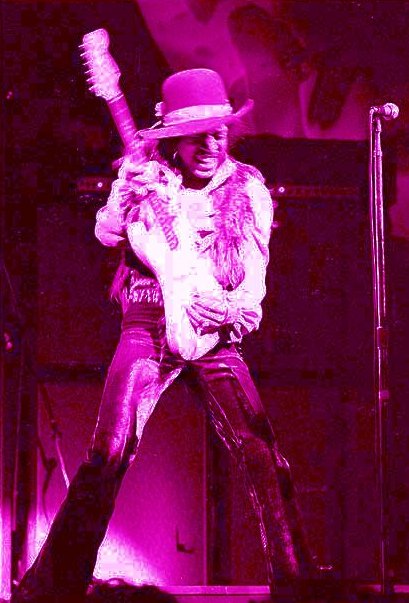
JIMI HENDRIX LIVE AT BERKLEY
5/30/1970








Wednesday, May 14, 2025
mailto:radioman2029
 yahoo.com
This is a nonprofit web site it is just a tribute to Jimi Hendrix
yahoo.com
This is a nonprofit web site it is just a tribute to Jimi Hendrix
This site is © Copyright Brian Harper 2004-2016, All Rights Reserved.

myspace web counter
Free web templates
|
|
|
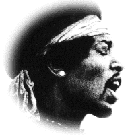
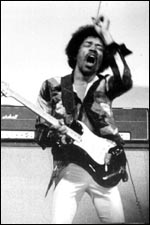

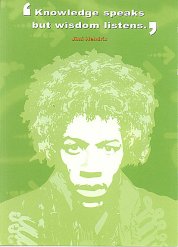


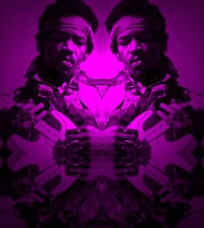
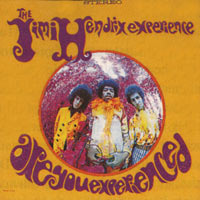

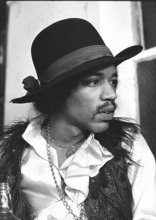
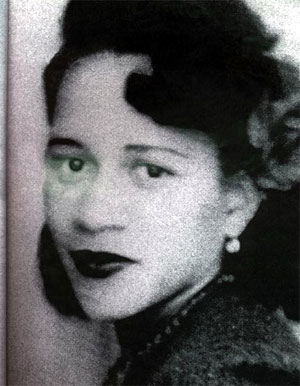
JIMI MOTHER
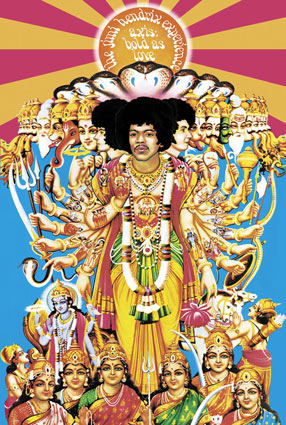
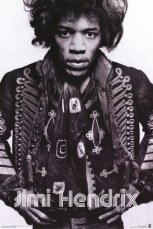
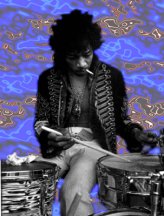
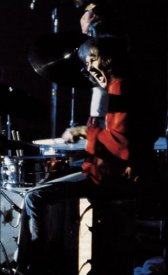 MITCH MITCHELL
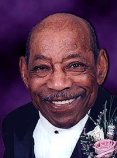 AL HENDRIX JIMI'S DAD





























































































|
|
